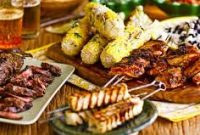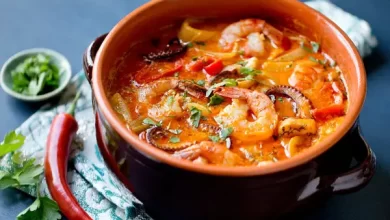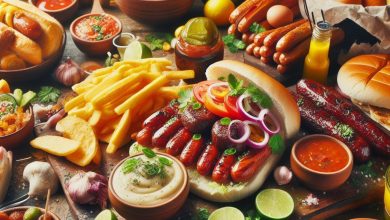What is the diet and food for Brazil? Is food important in Brazil? All Details
What is the diet and food for Brazil
Brazilian traditional cuisine:
Traditional Brazilian cuisine is diverse and reflects the country’s rich cultural heritage by fusing elements from indigenous, African, Portuguese, and other immigrants.
The following are a few popular Brazilian dishes and foods:
Feijoada: Often referred to as the national dish of Brazil, feijoada is a hearty black bean stew prepared with a variety of pig and cow meats, including sausage, bacon, and ribs. It’s typically served with rice, collard greens, and orange slices.
Coxinha: Made of dough that has been filled with shredded chicken, cream cheese, or other ingredients, these fried sweets are shaped like a teardrop. They are a popular street food and party food.
Acarajé: A specialty of Bahia are deep-fried black-eyed pea dough balls.
Moqueca: A delicious fish stew from Brazil made with tomatoes, onions, garlic, dendê palm oil, coconut milk, and a variety of other spices. In clay pots, it is flavorfully cooked and commonly served with rice.
Po de Queijo: These little cheese-filled bread rolls are a popular snack in Brazil. Since they are made with cheese and cassava flour, they have a chewy, cheesy texture.
A seasoned meal called farofa is created from toasted cassava flour with the addition of bacon, onions, and herbs. Feijoada and other Brazilian dishes usually have it as a side dish.
Pastel is a sort of deep-fried pastry similar to empanadas that can be filled with a number of ingredients, including cheese, palm hearts, or ground meat. It is a common street food.
With bread, shrimp, coconut milk, ground peanuts, and several spices, vatapá creates a rich, creamy sauce. It frequently pairs well with fish or seafood meals.
In Brazilian barbecue, also known as “churrasco,” various meat pieces, including cattle, hog, and chicken, are skewered and cooked over an open flame. It is typically seasoned with rock salt and served with farofa and vinaigrette sauce.
Quindim: A typical Brazilian meal, quindim is a delicious custard with vibrant colors cooked with sugar, egg yolks, and grated coconut. It has a silky, smooth consistency and is typically garnished with a layer of sugar that has been caramelized.
Brigadeiro: These chocolate truffles are a common Brazilian confection. These are made using condensed milk, cocoa, butter, and chocolate sprinkles.
Aça Bowl: Aça berries are native to the Amazon rainforest, but they are becoming more widely recognized as a nutrient-dense superfood. Brazilians make aça bowls by combining frozen aça pulp with various fruits and garnishes like granola, banana slices, and honey.
These are just a few of the delicious native foods that can be found all around Brazil. Brazilian cuisine offers a vast range of flavors, regional variations, and the use of fresh ingredients, making it a gastronomic delight for those who try it.

Is eating a priority in Brazil?
Yes, food has a big part in Brazilian life and culture. Brazilian cuisine is very diverse, reflecting the country’s size and multicultural heritage, and it plays a significant role in the daily lives of Brazilians. The following are some justifications for why food is so important in Brazil:
Native Brazilians, Portuguese colonists, ex-slaves from Africa, and immigrants from Europe, the Middle East, and Asia have all had an impact on the diversity of Brazilian culture. This diversity is reflected in the nation’s food, which offers a wide range of flavors, ingredients, and regional specialties.
Social Events: In Brazilian culture, interacting with others and spending time with friends and family are very important. Many social gatherings and events, such as barbecues (churrascos), feasts, and celebrations, heavily emphasize food.
Brazil’s vastness and geographic diversity result in a wide range of regional dishes and ingredients. The regional cuisines and specialties include things like churrasco in the south, moqueca in the northeast, and feijoada in the southeast.
Brazilian cuisine makes extensive use of street food, which offers a wide selection of convenient and delectable snacks and meals. Common street foods like coxinhas, pastels, and aça bowls are beloved by people of all ages.
Festivals and Celebrations: At Brazilian festivals and holidays, specialized cuisine and dishes are commonly provided. For instance, during Carnival, feijoada is well-liked, and during Festa Junina (June Festival), sweets made of corn are typical.
Cultural pride and identification: In Brazil, food is the source of cultural pride and identification.Brazilian cuisine commonly uses local and fresh foods, such as tropical fruits, fish, and various types of meat.
Brazilian food is renowned for its vibrant flavors because it places a high priority on using fresh ingredients. The food business has a considerable impact on Brazil’s economy, with agriculture, livestock husbandry, and food processing playing important roles.
Brazil is one of the top exporters of agricultural products globally. Tourism and gastronomy tourism: The food of Brazil attracts visitors from throughout the world. Tourists typically opt for local food and culinary experiences as part of their vacation trips.
In summary, food promotes social contact, upholds traditions, and showcases the rich culinary heritage of Brazil, playing a key part in Brazilian culture.



